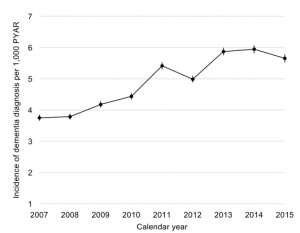I wanna hold your hand: helping young people prepare for happy healthy relationships
By guest blogger, on 11 July 2019

The teenage years are a time for experimenting and for pushing boundaries – particularly when it comes to intimate relationships. Such experimentation is a natural part of growing up. But there are potential risks, too – particularly if these early experiences aren’t positive ones. A new study from Professor Yvonne Kelly from UCL’s Department of Epidemiology and Public Health and colleagues, investigates what kinds of intimate behaviour 14 year-olds engage in, and asks how this insight can help to ensure young people are well prepared for healthy and happy adult relationships.
We know teenagers experiment with intimacy, often moving ‘up’ the scale from hand-holding or kissing to more explicitly sexual activity. But we also know teenage pregnancy numbers have been dropping in recent years. And our new study suggests that fewer young teenagers are actually having sexual intercourse than some might previously have thought.
We’ve all seen the headlines – studies have shown us (links) that 30 per cent of those born in the 1980s and 1990s had sex before the age of 16, and that among those born in the early 1990s a little under one in five had done so by age 15. But our new evidence, based on 14 year-olds born during or just after the year 2000, paints a rather different picture of this latest generation of teenagers.
Our research used data from the Millennium Cohort Study, the most comprehensive survey of adolescent health and development in the UK. It follows children born between September 2000 and January 2002 and has collected information on them at nine months and subsequently at age three, five, seven, 11, and 14 years. We used information from the most recently available data, when the study’s participants were 14 years old, and were able to look closely at the lives of 11,000 of them.
Intimate activities
Participants were asked about a range of ‘light’, ‘moderate’ and ‘heavy’ intimate activities. Handholding, kissing and cuddling were classed as ‘light,’ touching and fondling under clothes as ‘moderate’ and oral sex or sexual intercourse as ‘heavy.’
As might have been expected, more than half – 58 per cent – had engaged in kissing, cuddling or hand-holding, while 7.5 per cent, or one in 13, had experienced touching or fondling. But in contrast to other studies, (though our sample was younger than those mentioned above) we found only a very small proportion – 3.2 per cent or fewer than one in 30 – had been involved in ‘heavy’ activities in the year before they were interviewed for the study.
And most parents can take comfort from the fact that if their children aren’t participating in other risky activities such as drinking or smoking, they probably aren’t having sex either – there was clear evidence of links between heavier sexual activity and these factors.
We also found those who were most likely to confide worries in a friend rather than a parent, those whose parents didn’t always know where they were and those who stayed out late were more likely than others were to be engaged in heavier forms of sexual activity. Other potential links were found to drug-taking and as well as to symptoms of depression.
Our findings suggest young people who push boundaries may push several at once – that those who drink, smoke or stay out late, for instance, are more likely to engage in early sexual activity.
So, initiatives which aim to minimise risk and promote wellbeing are crucial – and they need to look at intimate activities, health behaviours and social relationships in relation to one another.
A key point is that if young people can learn about intimacy in a positive way at an early stage, then those good experiences can build foundations which will help them throughout their lives.
Most importantly young people need to know how to ensure their intimate experiences are mutually wanted, protected, and pleasurable. The concept of “sexual competence” – used to refer to sexual experiences characterised by autonomy, an equal willingness of partners, being ‘ready’ and (when relevant) protected by contraceptives – is important at all ages, as are close and open relationships with parents.
Better understanding of this interplay between personal relationships and behaviours are key to better support for young people. The right intervention at the right time can ensure a teenager’s intimate life is set on a positive course.
Partnered intimate activities in early adolescence – findings from the UK Millennium Cohort Study, by Yvonne Kelly. Afshin Zilanawala , Clare Tanton, Ruth Lewis and Catherine H Mercer,is published in the Journal of Adolescent Health.
*Afshin Zilanawala is based at the Research Department of Epidemiology and Public Health, University College London, and Oregon State University, United States.
Clare Tanton is based at London School of Hygiene & Tropical Medicine.
Ruth Lewis is based at the University of Glasgow.
Catherine H Merceris based at University College London.
This blog article is courtesy of the Child of our Time blog, which is a blog about the health and happiness of children living in the UK. led by the ESRC International Centre for Lifecourse Studies, University College London,
 Close
Close







